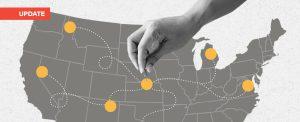In 2010, Australia took a monumental step forward in its approach to health care regulation. Regulators who previously operated on state- and territory-based licensing arrangements chose to consolidate all the country’s health regulation agencies into one national office: the Australian Health Practitioner Regulations Agency (Ahpra). At the helm of this transformation was Martin Fletcher, a leading health care regulator and now the 12-year CEO of the agency.
Today, Ahpra regulates roughly 840,000 health practitioners across 16 professions in the country. The Australian model has offered a prime example of regulatory consolidation gone right, with licensed professionals in the country able to freely work where they are needed, regardless of state and territory lines. In Part 2 of our interview series, Fletcher sits down with Paul Leavoy to discuss the impacts of the pandemic on health regulation, the potential of data-driven regulation, and much more.
I understand you recently launched the Ahpra service charter. Why did you have to launch this, and what is it all about?
We’ve had a big focus, in the past few years, on humanizing our regulatory process. It’s because whenever we talk to practitioners who are subject to a regulatory process – for example, there might be some sort of concern about their practice – we know just how stressful it can be for those practitioners. Whenever we talk to members of the public, they’ll tell us how hard it is to work out what we do and how it works and what to expect. So, for me, the service charter was about trying to establish what it is that people can expect when they are dealing with Ahpra.
It could be in relation to concerns, where a concern has been raised about you as a practitioner, or it could be you as a member of the community raising that concern. It could also be somebody who’s applying to be licensed or registered, or it could be somebody seeking information about some aspect of our work. Essentially, what the service charter does is set a series of principles – things like fairness, respect, transparency, responsiveness, empathy, and accountability – and then it translates those into what you can expect when you deal with us. It’s quite high-level, but it’s a start, and it’s an important part of our wider approach to trying to put the person at the center of all our regulatory processes and humanizing these processes.
It also sits in partnership with two other important things that we’ve developed. One is a set of principles regarding how we administer our legislation in terms of regulatory decision-making, and we also have a detailed regulatory guide which sets out all the ways in which we work throughout various regulatory processes. All that goes to this question of transparency and accountability, around us being as clear as we can be about the way that we work when we’re dealing with our practitioners and members of the community.
As a national regulator of health care, what were some of the greatest challenges you faced in coping with an international pandemic?
Like many organizations, we had to pivot very quickly from working in the office five days a week to working full-time on a remote basis. There was a huge amount of work involved in setting people up with the tools and approaches to be able to do that. I would say, looking back now over two years, in some ways I think we surprised ourselves about how quickly we were able to do that. It’s amazing what you can do when you have to do it. In fact, if a pandemic has a silver lining – and it’s hard to see any silver lining – but if it does have a silver lining, one of the things we’ve done is continue our flexible working arrangements.
We are now all back in our offices around Australia, and in most cases, we’ve moved to an arrangement where people are in the office a couple days a week and then can work at home a couple days a week as well. And that’s in response to the fact that people, for all the challenges the pandemic brought, liked working remote. What we’ve tried to do, like many organizations in this hybrid mode, is bring together the best of remote working with the best of office working, because of course people like to connect with colleagues, and there’s nothing like seeing your colleagues and workmates in the office as well.
How would you characterize your technological readiness to approach that hybrid work environment at the time?
I’d say it was limited. We had to do things like mass purchase laptops – and there were all sorts of supply chain issues at that time – and create the ability for people to log onto secure systems. We had to expand substantially in terms of bandwidth for people to be able to do that. We had to create virtual working platforms and do all the things other organizations had done around Zoom and Teams and Webex and all those products we’ve come to know. We also had to make sure all our services were available online. For example, people applying for registration or licensure had to be able to do that online.
We, as part of our registration process, have a proof-of-identity check, which typically involves people coming into our office and confirming that they were who they said they were, particularly in the context of international health practitioners coming to Australia. We had to find a way of doing that, even though all our offices were closed, and ultimately, we did it through employers. My other reflection would be that there were a lot of changes we put in place, and one of the things we’ve tried to do is look at those changes to decide which were changes that we want to maintain and which of those changes we want to back out of as quickly as we can. There have been some good things that have come out of this for us, in terms of accelerating that move to the online environment, that might have otherwise not have happened at this pace.
One of the things we also did, like many other regulators around the world, was create a surge workforce – bringing back into licensure and registration people who had recently left registration to be available to assist the health system (and then, in the past 12 months, assist with the vaccination rollout). In a number of cases, we also eased our regulatory requirements, like, for example, requirements around continuing professional development, in recognition of the fact that healthcare workers at the frontline were dealing with some enormous challenges. So, again, there are things we only wanted to put in on a temporary basis, but they were in recognition of the extraordinary circumstances everyone was facing.
I think there have been some good lessons for us, notwithstanding the overall sense that COVID makes everything harder for everyone. It’s interesting when we talk to staff – I think there’s a real sense of tiredness and fatigue for people as well that’s an overlay of what we and many others are experiencing, particularly in some cities in Australia where we had very extended periods of lockdown. I think it meant we had to have a very strong focus on staff health and well-being as well. For a period, we reduced our performance expectations of our staff in recognition, for example, that we had a lot of staff who had to homeschool their children because the schools were closed. There were a lot of ways COVID made things much harder. But there were also some things that came out of it from our point of view that are changes that we’re continuing, particularly around this flexible working arrangement.
Do you find questioning the utility of the standards that were mitigated in response to the pandemic to be a good inward-looking exercise?
There are two edges of the sword in terms of easing requirements. On one hand, it’s a recognition of the extraordinary pressures particularly frontline workers were under during various stages of the pandemic. On the other hand, it perhaps does play into a narrative that regulation is a burden, whereas I think we would argue that those standards are important for ensuring quality and safety of health professionals. There’s a balance to be struck there. That’s why I think there’s that lens of “which of these changes are overdue, which of them are arguably things that weren’t needed, and which of these things are actually important in terms of the ultimate role and focus of regulation on patient safety and public protection?”
I’d also add that I think one of the biggest challenges for us, and I know this is something we share with professional regulators particularly in North America, is responding to misinformation and disinformation in relation to COVID-19, vis a vis the wider importance of freedom of speech, etc. I think determining where the public interest lies in that and what the balance of that is has been hugely challenging for us, as I know it has been for others as well.
Sexual boundary issues have always been an area of concern in health care regulation. I understand Ahpra has taken those quite seriously, and I understand you’ve done a lot of work in addressing that yourself. Can you provide a bit of context around the issue and the challenge it presents for you?
Like many regulators around the world, we’ve had our share of high-profile cases which have highlighted shortcomings in the regulatory approaches that have been in place to protect the public. If I run back a few years, we had a high-profile case in Australia where a medical practitioner had come to the attention of Ahpra and the Medical Board of Australia. At the time, what we called chaperone conditions had been put in place. This was essentially a requirement that somebody else be in the room whenever this practitioner was treating a patient, to keep patients safe. The allegation that came out there was that in fact that practitioner had been able to continue to abuse patients even while the chaperone was in the room.
That was alarming for us, that the regulatory protective measure that had been put in place appeared to not be doing the job it needed to be doing to keep patients safe. We were fortunate to be able to commission an eminent worldwide expert, Professor Ron Patterson from New Zealand, to completely review the way that we were dealing with allegations of what we would call sexual boundary violations, particularly this question of chaperone conditions that are used widely around the world by regulators, and his conclusion was that chaperone conditions were not effective in protecting the public and they were actually out of touch with community expectations as well.
Off the back of his report, he made several recommendations. We moved away from the use of chaperone conditions for sexual boundary violation allegations and either moved to gender-based restrictions or complete suspension – stopping a practitioner for practicing while we investigated further the allegations. We also created a special decision-making committee to deal with all these matters in medicine, recognizing the specialist nature of the issues they raised, and put together a team of investigators who put a lot of focus on developing knowledge and skills and understanding of some of the unique features of these situations, both for survivors and the practitioners involved.
All this coincided with a royal commission we had in Australia that was looking at institutional failures in relation to historic allegations of sexual abuse. The role of churches, scout movements, charities, orphanages, and the like, going back years, has highlighted a huge issue of people being survivors of sexual abuse where that had never been recognized or dealt with. That gave us an important focus as well. The other thing we’ve done most recently is create something that we call a notify support service. We’ve employed two social workers within Ahpra, and we link them with both survivors and witnesses, when they’re going through the investigation process (or perhaps, for example, going to a tribunal), to help support them to navigate the process.
We know it can be incredibly retraumatizing for people to go through these processes, but it’s important from our point of view not only that we support people well but also that we get an outcome that is protective of the public more widely where we’ve got theses serious concerns. It’s been a huge focus for us. I’d say we’ve completely reengineered our approach. We continue to reform it, and, sadly, see more cases come forward, but it’s probably good that people are feeling able to raise their concerns.
Why would something like chaperoning, with its embedded oversight, not work?
There’s a range of reasons that Professor Patterson’s review indicated as to why chaperones weren’t doing the job they needed to do to protect the public. One very practical one was that it appeared often possible that somebody, for example, could examine a patient behind a curtain, while the chaperone would be in the room but would not actually witness the examination. It would also at times be difficult for a chaperone to know whether a form of intimate examination was clinically indicated or not. There might be that differential in terms of clinical knowledge. And, often, the chaperone might have been an employee of the practitioner, so you also had that power differential between the practitioner in a powerful position and the chaperone who was less powerful.
There were also a wider set of issues around how we educated and trained chaperones as well to really understand the role. Ultimately, the conclusion from Professor Patterson was that, first of all, even if you could address all those things, chaperoning still fell short as a public protective measure, and secondly, chaperoning was no longer (if it ever had been) consistent with what the community expected. Even the word “chaperone,” when you think about it, is quite a dated term. I know a lot of countries have moved to talking about practice monitors, for example, as a more contemporary language. It was no longer what the community expected where there were serious concerns being raised.
How would you characterize your agency’s maturity against your aspirations regarding the use of data in your work?
To me, data is an important part of what it means to be a risk-based regulator. It’s about informing regulatory insights and regulatory intelligence. One of the benefits of having a national approach to regulation is that we’ve got nationally consistent data across all 840,000 registered health practitioners. We’ve got nationally consistent registration types, and we’ve got complete capture of data that relates to concerns that have been raised about practitioners as well.
I think our challenge is about the amount of data we have and how we work out the ratio of noise to signal and identify those things that inform our regulatory intelligence and our approach to risk assessment. We’ve been looking at data strategy, which tries to articulate how we want to do that, we’ve developed a research strategy (and we’ve got a research unit embedded within Ahpra that is helping us to look at the data and analyze it), and we’ve published a lot of workforce data. That’s been a benefit of the National Registration and Accreditation Scheme, that we have the ability to present data on workforce profiles and create analytics looking at the distribution of workforce across professions and within professions. That’s been incredibly helpful in terms of workforce policy and planning.
If I look forward to our next stage, it’s actually to move to a big program called our Transformation Program, which I think [confronts] the next challenge for regulation around how we all embrace the opportunity to go digital – not to be IT-driven, but to be able to deliver the sort of experience for the public, for registrants, for applicants, for people who deal with us, in this world we now live in. I think ultimately that will system-enable a lot of the data work that we want to do. At the moment, we tend to have to work around our systems because they were never set up for this sort of work, so I think that system enablement is going to be important. I’d firmly locate this in the context about what it means to be a risk-based regulator and what it means to have regulatory intelligence and insight, which is ultimately then about how you match your analysis of risk to your choice of regulatory tools.
Where do you think Australia could learn or is learning from other countries in terms of health care regulation?
We learn a lot from our collaboration with others and we’ve been very interested in and have a very regular liaison with Canada, the U.S., the U.K., and New Zealand. We’re also very active in the International Association of Medical Regulatory Authorities, which brings a much wider group of medical regulators together, and we’re also very active in groups like CLEAR (the Council on Licensure, Enforcement, and Regulation), and it goes even wider.
I hope we’ve got something to offer with our experience, but I’d go back to my earlier comment that despite the differences in how we organize regulation and how we organize our health systems around the world, the challenges are very common and it’s always incredibly interesting to hear about how others are dealing with some of the challenges that we’re facing. We talked earlier about misinformation and disinformation – it’s interesting to learn about, particularly from North American colleagues.
There are two other areas where we’ve been very keen to learn from others. We have a major review underway around cosmetic surgery – again, high-profile cases in the media have been raising major concerns about allegations that practitioners are putting profit before patient safety, and that’s meant we had to look again at our whole approach to how we regulate this as a rapidly growing area of practice. We’ve been talking to colleagues around the world about what people are doing in that space.
Particularly in the Canadian context, I also want to highlight the focus around First Nations people and the role of regulators in addressing inequities, addressing cultural safety, and addressing racism in our health systems, particularly as it relates to First Nations people. We’ve been incredibly interested in the experience and journey of Canada in particular, and it informs the work that we’re doing as it relates to aboriginal peoples in Australia.
Check out Part 1 of our interview series here or listen to the full Ascend Radio episode here.
MORE INSIGHT

‘The people piece’: The key role of people in regulatory transformation
Regulatory transformation is not only about changing an organization’s technology and processes; it is also about empowering and engaging its people throughout the journey. In this article, Rick Borges looks at the key role that people play as enablers of regulatory transformation.

Playing in the sandbox: Old regulators are learning new tricks
Regulators are increasingly turning to an innovative policy tool called a “sandbox” to address various challenges. In this article, Contributor Will Morrison explores the origins of regulatory sandboxes and how they work.

Regulators tackle operational resilience in the UK
To mitigate the risk of major operational failures affecting the day-to-day lives of millions of financial services customers, U.K. regulators issued new rules on operational resilience that came into force in March 2022. In this article, Rick Borges looks at the requirements and the impact they will have on firms’ cyber resilience and use of third-party providers.

An exhaustive breakdown of interstate compacts in the U.S.
Just how many interstate licensing agreements are active in the U.S.? And in which professions are regulators looking to further promote license mobility? In our latest Ascend article, we take an in-depth look at the country’s largest active and pending multistate licensing agreements.

How the U.K.’s new Consumer Duty will change how firms operate
On July 31, the U.K.’s Financial Conduct Authority (FCA) will begin enforcing a new Consumer Duty that will set higher and clearer standards of consumer protection across financial services and require firms to put their customers’ needs first. In this article, Ascend Contributor Rick Borges explores the impact this change will have on how firms operate.

Cayton asks ChatGPT: Is AI a good thing or a bad thing?
Is AI a good thing or a bad thing? It’s a question that’s currently top of mind for lawmakers and citizens alike as the development of increasingly powerful AI technologies continues at a rapid pace. As Harry Cayton recently contemplated this question, he decided to ask ChatGPT to see what it had to say.








